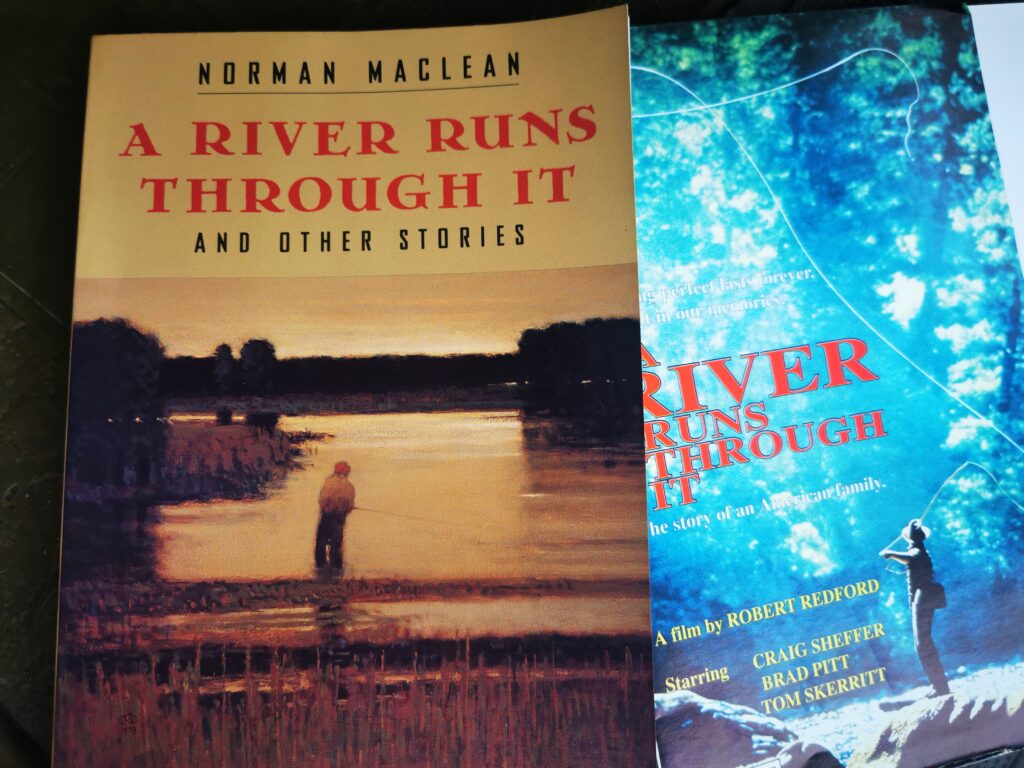It has been many years since I read “A River Runs Though it” by Norman Maclean. The story is of course famous, from Robert Redford’s movie produced in 1992, but I think few people are familiar with the 1976 book that inspired the movie.

I say that the book inspired the movie, because what many seem to forget is that the movie differs from the written story. In fact the movie brings in elements of two stories which appear in the same book, and to which the full title alludes. “A River Runs Though it, And other stories”. So the movie is not, strictly speaking, just the story made into a film.
In re-reading the book recently, I developed a keen appreciation for the mastery of the movie produced by Redford. For example Redford condenses two scenes involving Neil and his “whore”, into one that captures the essence of it all. Two sets of sunburn; and of disappointment in his brother-in-law; and being at the brunt of the anger of the womenfolk in his wife’s family . And yes, Maclean does refer to the lady of the divided skirts as a “whore”, and in all three stories in his book, he displays a western coarseness which Redford delivered slightly more subtly, and in an aura of nostalgia which served to take the edges off. Redford makes no reference for example of the two brothers chasing the self same whore down the street “kicking her in the ass”. You will notice too, that I write here of Maclean’s wife, and brother-in-law, because the story takes place after they are married, and after his time in the forest service. The movie of course brings in the love interest by placing the story during Macleans courtship of his wife, and before his time in the Forest Service.
But quite aside from re-arranging the life sequence, you find many lines in the book which you will recognize from the movie. In other words they are quoted verbatim. The parts not quoted are of course the descriptions of people, and landscapes, but Redford captures these beautifully in the movie. Another part not repeated verbatim, is of course the subtlety of relationships and attitudes and outlook, and emotion, and herein lies Redford’s mastery. He somehow manages to capture these elements, which Maclean unpacks in detail in the written word, and does so by capture of light, facial expression, body language, background sound, and camera angle. The fact that I did a reverse analysis by reading the book after I saw the movie, and recognized these elements in the book, because I had picked up on them in the movie, speaks volumes for the skill of the movie maker.
As a fisherman, I delighted in some of the technical fishing detail contained in the written version. There was a little in there that would not have made it into a commercial production, seeking a broad audience, but which is of great interest to us technical flyfishing types.
In reading it again, I was struck by the unlikely product of academia that Maclean became as a professor of English, given his Rocky mountain upbringing amongst men “as tough as their axe handles”. His language skills of course gave him the ability to tell his family’s story with a resigned dignity and reverence that has one sighing in a sad and appreciative compassion as you turn the last page. Although I didn’t pick up on it when I read the book many years ago, as I came to the end this time around, I was left with a deep appreciation for this little masterpiece.
If you haven’t read the book, I can recommend it.
One Response
Thanks, the book is a classic.